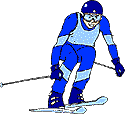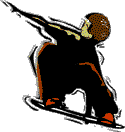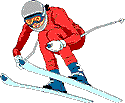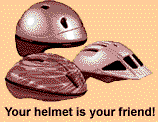Neuroscience For Kids
Helmets for Winter Sports
 December 5, 2007
December 5, 2007
If you are heading up to the slopes for some skiing or snowboarding, don't forget your helmet! It could prevent a serious brain injury.
 Researchers in Canada reviewed the findings from 24 articles published
between 1990 and 2004 that studied skiing and snowboarding injuries.
They found that the number of traumatic brain injuries (TBI) and spinal
cord injuries (SCI) is increasing. Head injuries account for 3-15% of all
injuries and spinal cord injuries account for 2-4% of all injuries
suffered by snowboarders and skiers. Also, snowboarders were more likely
to injure themselves than skiers.
Researchers in Canada reviewed the findings from 24 articles published
between 1990 and 2004 that studied skiing and snowboarding injuries.
They found that the number of traumatic brain injuries (TBI) and spinal
cord injuries (SCI) is increasing. Head injuries account for 3-15% of all
injuries and spinal cord injuries account for 2-4% of all injuries
suffered by snowboarders and skiers. Also, snowboarders were more likely
to injure themselves than skiers.
 The researchers suggest that the increase in TBI and SCI may be due to
new developments in equipment and terrain found on the slopes. For
example, some ski/snowboard parks have special areas for jumps or
acrobatic moves. Attempts to use these features, especially by
inexperienced skiers and snowboarders, may result in more falls or
collisions.
The researchers suggest that the increase in TBI and SCI may be due to
new developments in equipment and terrain found on the slopes. For
example, some ski/snowboard parks have special areas for jumps or
acrobatic moves. Attempts to use these features, especially by
inexperienced skiers and snowboarders, may result in more falls or
collisions.
 In 1999, the US Consumer Product Safety Commission
estimated that helmets worn by skiers and snowboarders under 15 years
of age could prevent or reduce the severity of 53% of the head injuries.
Helmets worn by adults would prevent or reduce the severity of 44% of the
head injuries. The devastating, long-term consequences of a brain or
spinal cord injury make it clear that helmets are a good idea!
In 1999, the US Consumer Product Safety Commission
estimated that helmets worn by skiers and snowboarders under 15 years
of age could prevent or reduce the severity of 53% of the head injuries.
Helmets worn by adults would prevent or reduce the severity of 44% of the
head injuries. The devastating, long-term consequences of a brain or
spinal cord injury make it clear that helmets are a good idea!
 Ski/Snowboard Safety
Ski/Snowboard Safety
- Slow down!
- Ski and snowboard under control!
- Ski area operators should pad lift towers, trees and other objects on the slopes.
- Ski area operators should label all trails carefully so inexperienced skiers and snowboarders stay off steep terrain.
- "WEAR A HELMET" - one that fits properly
Reference:
- Ackery, A., Hagel, B.E., Provvidenza, C. and Tator, C.H., An international review of head and spinal cord injuries in alpine skiing and snowboarding, Injury Prevention, 13:368-375, 2007.
Copyright © 1996-2007, Eric H. Chudler, University of Washington
